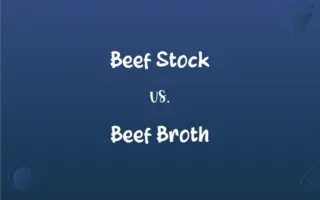Adhesion vs. Cohesion: What's the Difference?
Edited by Janet White || By Harlon Moss || Updated on October 13, 2023
Adhesion refers to the attraction between different substances, while cohesion involves the attraction between similar particles or molecules.

Key Differences
Adhesion involves the interaction and attraction that exists between molecules of different substances. This phenomenon is what enables water to stick to a windowpane. Conversely, cohesion represents the force of attraction between like molecules, which is evident when water droplets merge together, demonstrating a unity due to similar molecular forces.
When discussing adhesion, the concept often extends to scenarios such as paint adhering to a wall or tape sticking to a surface. Cohesion, however, plays a pivotal role in phenomena like surface tension, where the molecules at the surface of a liquid, like water, stick together to resist external forces.
Adhesion can introduce considerations regarding how various substances, such as liquids and solids, interact and bind together. The mechanisms of cohesion are key to understanding why substances, such as water, can form droplets, since the molecules within the substance are drawn to one another.
In biological contexts, adhesion may refer to cellular interactions with surfaces or other cells, a vital process for numerous biological functions. Cohesion, in a similar context, might be reflected in the tendency of similar cells or molecules within a substance to clump or stay together, demonstrating a uniform interaction.
Adhesion and cohesion, though distinct, can often work in tandem. For instance, capillary action in plants involves both - adhesion of water to the plant vessel walls and cohesion between water molecules, facilitating the upward movement of water against gravity. This intertwined functionality showcases the necessity and ubiquity of both phenomena in natural processes.
ADVERTISEMENT
Comparison Chart
Basic Definition
The tendency to adhere to different types.
The tendency to stick together.
Linguistic Relevance
Atypical and not standard.
Commonly discussed in text linguistics
In Writing
Might metaphorically refer to the way disparate ideas or elements in a text are joined or linked
Refers to how well the elements within a text connect and flow logically from one to the next
Textual Aspect
Could imply the connection between different paragraphs or sections which are thematically different
Concerns the logical and grammatical connections that improve readability within a paragraph or between sentences
Example Application
A text might be said to demonstrate "adhesion" by awkwardly linking dissimilar ideas or themes
A text shows "cohesion" by using connective words and consistent themes to create a smooth, logical flow
ADVERTISEMENT
Adhesion and Cohesion Definitions
Adhesion
Adhesion pertains to the sticking of different substances due to intermolecular forces.
The adhesion between paint and wall enables a uniform coat of color.
Cohesion
In a social context, cohesion implies a form of unity or sticking together among group members.
The cohesion among team members was evident in their synchronized activities and communications.
Adhesion
Adhesion can involve the binding of a liquid to the surface of a solid.
Water exhibits adhesion when it spreads across a glass surface.
Cohesion
Cohesion describes the tendency of similar particles or molecules to stick together.
The cohesion between water molecules allows droplets to form and maintain their shape.
Adhesion
Adhesion can also refer to the process through which different molecules attract each other.
Due to adhesion, ink can stick to paper, allowing us to write and print documents.
Cohesion
Cohesion refers to the attractive force that holds alike substances together within a singular form.
Surface tension is created by the cohesion of water molecules at a liquid’s surface.
Adhesion
Adhesion is a phenomenon where distinct materials hold together at their interface.
The adhesion of a sticker to a notebook involves forces at the interface of the two.
Cohesion
In linguistics, cohesion is the use of linguistic devices to link sentences and paragraphs coherently.
The use of pronouns contributes to the cohesion in text, as they refer back to previously mentioned entities.
Adhesion
In biology, adhesion may describe cells binding to different cellular or material surfaces.
Cellular adhesion allows white blood cells to attach to the walls of blood vessels.
Cohesion
Cohesion in writing means ensuring that all ideas and sections are logically linked and unified.
Her essay lacked cohesion because the paragraphs seemed to discuss unrelated topics.
Adhesion
The process or condition of sticking or staying attached
The adhesion of the glue to wood.
Cohesion
The act, process, or condition of cohering
Exhibited strong cohesion in the family unit.
Adhesion
(Physics) The physical attraction or joining of two substances, especially the macroscopically observable attraction of dissimilar substances.
Cohesion
(Physics) The intermolecular attraction by which the elements of a body are held together.
FAQs
What is adhesion?
Adhesion refers to the attractive force between dissimilar substances or materials.
Are adhesion and cohesion the same?
No, adhesion involves different substances, while cohesion involves identical substances.
How does adhesion occur?
Adhesion occurs through intermolecular forces between different materials.
Can adhesion and cohesion occur together?
Yes, they can act simultaneously, as seen in phenomena like capillary action.
What is an example of adhesion?
Water sticking to a glass surface is an example of adhesion.
How does cohesion manifest in liquids?
In liquids, cohesion can lead to surface tension and the formation of droplets.
Is cohesion responsible for mercury forming spherical droplets?
Yes, cohesion among mercury molecules causes them to form spherical shapes.
What role does cohesion play in water transportation in plants?
Cohesion helps water molecules stick together, assisting in their upward movement through plants.
Can cohesion be observed in solid materials?
Yes, cohesion in solids helps maintain their shape by keeping their particles bound together.
How is cohesion defined?
Cohesion pertains to the attractive force that causes similar particles or molecules to stick together.
How does cohesion contribute to surface tension?
Cohesion causes similar molecules at the surface of a liquid to pull together, creating surface tension.
Why is cohesion vital in molecular biology?
Cohesion helps similar molecules or cells stay together, facilitating various biological processes.
What is a practical application of adhesion in daily life?
Adhesion is utilized in gluing objects, where a substance binds materials together.
What causes cohesion?
Cohesion is caused by attractive forces between similar molecules or particles.
Is adhesion only related to liquids?
No, adhesion can involve various states of matter, such as a solid and a liquid.
What adhesive forces are involved in adhesion?
Adhesive forces can include van der Waals forces, hydrogen bonding, and mechanical forces.
How is cohesion related to viscosity in liquids?
Higher cohesion in a liquid generally correlates to higher viscosity, as the molecules stick together more.
Can adhesion occur in gases?
Adhesion typically involves solids and liquids, being less relevant in gaseous interactions.
Does adhesion always require two different substances?
Yes, adhesion specifically describes the binding force between different substances.
How does adhesion affect painting?
Adhesion ensures that paint sticks and stays on the surface being painted.
About Author
Written by
Harlon MossHarlon is a seasoned quality moderator and accomplished content writer for Difference Wiki. An alumnus of the prestigious University of California, he earned his degree in Computer Science. Leveraging his academic background, Harlon brings a meticulous and informed perspective to his work, ensuring content accuracy and excellence.
Edited by
Janet WhiteJanet White has been an esteemed writer and blogger for Difference Wiki. Holding a Master's degree in Science and Medical Journalism from the prestigious Boston University, she has consistently demonstrated her expertise and passion for her field. When she's not immersed in her work, Janet relishes her time exercising, delving into a good book, and cherishing moments with friends and family.































































